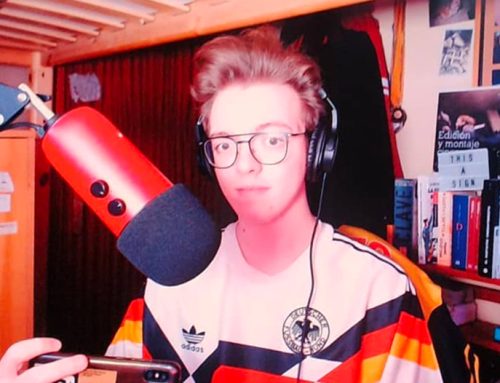Barcelona’s need to produce a free media has its roots in a deeply troubled time more harrowing and complex than its current residents would want to imagine. our current-day access to independently-produced radio is partly thanks to the efforts of several groups whose activity can be traced back to the Spanish transition to democracy.

Catalunya’s first indie station was Ràdio Maduixa, founded in Granollers in 1977, followed by the short-lived Campana de Gràcia and Ona Lluire, the latter forcefully shuttered by authorities on several occasions. Although none would establish itself as a long-serving broadcaster, they laid foundations for the following decades emerging stations, most notably: Ràdio Pica, a highly politicised fm station which continued to broadcast until 2012 and is still online today, Contrabanda Fm, a volunteer pirate radio, and Ràdio Bronka, another pirate that only recently ceased to broadcast. Technological advances in the last 20 years have made a new and cheaper type of radio possible.
Radio Gladys Palmera
Alejandra Fierro Eleta is a noble lady of Asturian and Panamanian heritage, currently living amongst her magnificent personal library of Latin music on her late grandfather’s estate San Lorenzo de El Escorial, close to the royal palace. Her endless shelves contain a wealth of Cuban music as well as Latin jazz and salsa and are beginning to find themselves surrounded by Brazilian and African sounds. Counting vinyl, CDs, cassettes and reel-to-reel, this wonderful collection, said to be the world’s largest, contains over 100,000 specimens.
Keen to create a platform to share these tunes, she decided to launch a radio station in 1999, sharing an FM frequency and studio with Ràdio Pica in Barcelona, whilst also opening studios in Madrid and Valencia. Her father didn’t support the activity and wouldn’t lend the family name to the project, so the station took her nom de guerre: Radio Gladys Palmera. The station went completely digital in 2010, and now takes the format of radio and video on demand, with 16 programmes dedicated to music with Latin roots. Álex García Amat is the head of programming at the Barcelona studio, one of four people employed full time. He explains that there is no traditional advertising to ‘dirty the antennas’, nor do they receive any grants. Until now, they have supported themselves through production of radio and event management for third-party clients.
In many ways, the station is the most popular independent radio station in the country. Their programmes are faithfully followed locally, nationally and internationally, with particular interest in their content coming from Colombia. They boast an array of fine presenters, including respected cultural journalist Diego A. Manrique and new flamenco icon Martirio. Their YouTube channel is incredibly popular, and can pull in over a thousand euros per month. In 2015 they were awarded the Ondas Prize for the best online radio station in Spain. The Gladys Palmera collection of records is constantly growing and slowly being transferred to digital formats to share: of particular interest to fans of extremely rare pre-revolution wax from Cuba.
The operation seems to be running well, according to García. He can demonstrate over 70,000 visits to the website each month, in addition to streaming via Tune In, iTunes and Ivoox. There are over a million YouTube plays per month. The station, however, will adapt with the times and there are changes ahead. For example, they’ll overhaul the website in September ‘to resemble Netflix’. His own show, ‘Future Beats’, will adopt an interactive style, where the listener can filter which music is presented, in what order and for how long. As for the collection of cultural artefacts, Fierro has said that she will one day donate it all to the University of California, Berkeley, in return for scholarships for Panamanian students. Presumably, by that time, copies of it all will exist in the cloud, ready for transmission by informed DJs.
Scanner FM
Founded in 2004, Scanner FM first shared an FM frequency with the public Ràdio Gràcia until 2008, occupying evenings and weekend slots. Several of the founding members are still actively involved in the station, namely Carlos Medina, Bruno Sokolowicz and Mónica Hidalgo. They broadcast live from 7pm – 9pm Monday to Friday, a timetable dictated by the availability of the volunteer presenters. In 2015 they secured their current studio, a roomy space on Carrer Príncep de Viana in the Raval, a street with genuine neighbourhood feel that is coincidentally close to various music schools and the Jazz Sí bar.
Although the live content may be limited, the studio allows Scanner FM to host band showcases, which they often broadcast on Facebook live, allowing their 10,000 followers better access. This format is limited to live performances, however, as Facebook takes down streams of unlicensed music. There are also over 30 programmes available via their website, updated on a regular basis, including established shows such as Via Aeria, which covers the electronic scene, 2000 Enemigos Mortales, dedicated to burgeoning indie bands, and Canela En Surco, unearthing rare disco and house.
Medina and Hidalgo are content with the station, but agree that its halcyon days are in the past. In 2005, shortly after appearing on the airwaves, they were awarded the prestigious Ondas Prize for their coverage of that year’s Primavera Sound festival. In 2006 it became the first Internet radio station in Spain, and has covered major local music festivals since then. These days it has much more competition both locally and internationally, but holds a special place in Barcelona’s radiophonic history. And the station still claims to have an audience of 100,000 plays monthly.
Dublab.es
Dublab.es is the fruit of the labour of four dedicated Catalans who now manage four hours of live broadcasting each weekday, reaching 5,000 people per month with content provided by some of Barcelona’s most progressive DJs, selectors and collectives. A chance meeting at BeCool in 2007 with the consolidated Los Angeles-based Dublab founder, Frosty, began a relationship that has resulted in this permanent sister station now operating out of a modest studio in Gràcia.
Currently, Cristian ‘Cosmic D’Alessandro’ Subirà, Carles Yagüez and Guille ‘Stooge’ Campo manage all aspects of the station, which is completely independent. They have neither advertising nor council grants to keep operations alive. Commercial pressures are no concern for them, and they maintain that they are not motivated by plays, likes or friendships. Resident DJs are photographed from behind on the website, and music and genres from the fringes carry equal weight as more popular sounds and styles.
Predating the launch of dublab.es and serving as a precursor for the Catalan franchise, Latitudes is a weekly presentation by Subirà in his guise as the serene Cosmic D’Alessandro. He addresses listeners from the depths of space, piloting a programme of progressive rock and new age music that sweetens the reality of a Monday afternoon in front of the laptop. Other shows vary greatly from there, and listeners tuning in from 5pm-9pm the remainder of the week can take in broadcasts such as the outlandish cyber-kitsch findings of Canadá associates Club Marabú Lu+9 / So Pepi, the sadistic industrial sounds of Cønjuntø Vacíø’s X ≠ X, or Los Secretos de Tesla by Wah Wah Records’ DJ Shak, who shares forgotten tracks from the last century.
The group of presenters are indeed eclectic, but the founders’ insistence that DJs present their shows live has created a sense of community uncommon at many Internet stations, facile as it is to pre-record shows or broadcast remotely. The team speak fondly of their family of collaborators as representing classic and emerging tastes in music, heartfelt and vital. They try to demonstrate that presenters are valued by sourcing paid residencies at the likes of Casa Bonay and Palo Alto Market, and last month organised gigs alongside illustrious guests that were broadcast parallel to Primavera Sound. They also generate occasional income at events such as the Independent Label Market and in collaboration with Arts Santa Mònica. The model, for the moment, is a significant associative commitment for the love of the art. Until a sponsor offers to support the station in an unobtrusive way, such as with Converse at Red Light Radio in Amsterdam, dublab.es will cover basic costs and not much else. Carles explains: ‘We’d like to live off Dublab. Fortunately we don’t need to’.
Barcelona City FM
Radio is a very personal medium, and many will feel closest to a station that speaks their own language. According to Barcelona City FM, the Catalan capital is home to around 330,000 people who regard the Queen’s as their mother tongue, and who have enjoyed the ever-increasing live programming provided by the station since late 2015. With the help of an FM frequency, they claim to reach over 50,000 listeners each month, and the programmes include practical shows for expats, chat shows as well as a solid selection of music broadcasting. Initially sharing a studio with Scanner FM, they now transmit from Poblenou.
Lottie ‘Tottie’ Moore and Michelle ‘D.N.S.’ Hardiman are two English presenters who have found a home for their selections on the station. Their shows Track Family and Groove Control go out weekly and focus on the deeper sides of dance music. Moore had little experience on the airwaves before desperately searching for a supporting cast to fill a slot vacated last minute on the station.
Luckily, her compatriots Owen ‘El Rey de la Gamba’ Pidcock and Danny Parr were happy to oblige, and the Facebook community they had previously used to share tunes morphed easily into the beginnings of a faithful listenership. The trio are naturals in the studio, and playful patter bookends sections of cheerful but respectable dance tracks. Debuts have been given to several local DJs now on the up, and international guests such as Palms Trax and Rory Phillips have filled guest slots, adding traction to the burgeoning station.
Hardiman had more experience before pitching up in Barcelona, previously having broadcasted on the semi-pirate House FM in London. The 10-pound offering presenters were expected to leave in a safe at the studio at the beginning tested her generosity of spirit, but these days she only donates her time, putting together a solo show each week. Her late evening sessions of gritty upfront singles are well worth a listen.
Aside from the occasional gig off the back of their shows, neither presenter gets anything tangible back from their efforts. But they were contacted by Sónar to cover the Women In Sónar project and, despite the gruelling schedule of appointments and shows, were delighted to be invited to help produce a series of 360-degree video interviews with high-profile female artists that will be published on the Barcelona City FM Facebook in the coming weeks. Both Moore and Hardiman acknowledge their contributions’ shortcomings and identify room for the station to improve, but are also committed to learning and being more involved in an increasingly active scene.
In Barcelona there are many reasons to stay online, underground and independent. Although FM frequencies are available, one must have six-figure reserves in the bank in order to be granted a license. Even then it seems incredibly difficult: one of the people interviewed for this piece was asked to purchase an FM license legally on behalf of a rich foreign investor, and the task proved impossible due to the lack of official concessions. FM radio is still widespread and small pirate stations are all over the airwaves, apparently tolerated by authorities if the station does not have commercial interests. Its days seem numbered, however, as the smartphone becomes the preferred way of consuming music: a tendency that will only aid Barcelona’s emerging radio broadcasters.
Barcelona’s independent stations present passion and commitment to providing specialised programming, unavailable through mainstream FM stations, with little financial reward in exchange. Unlike the previous generation of pirate stations, their discourse isn’t communicated through any sort of explicit narration, but via musical choices and a contemporary manner of publication. The medium is the message.







